In Our Midst
By Laura Stephenson Carter
When neonatologists save a premature infant, what does the future hold for the baby? Caregivers can't predict with certainty. They struggle even with what to tell the parents. But now, a new documentary produced at Dartmouth may help both providers and parents face the long-term ramifications of some of modern medicine's toughest issues.
"They were born more than three months early, twin brothers who weighed only three and a half pounds between them. . . . The doctor's voice was soft and his words deliberate. Randall, he said gently, will probably never walk, never speak, never feed himself. He will likely never see or hear. . . . The parents hugged tightly, as if they wanted to disappear inside each other and leave behind this sterile room, this grim news. Perhaps they were already beginning to suspect the agonizing decision they would be asked to make. There would be no easy choices . . ."
These compelling words from the Spring 1997 issue of Dartmouth Medicine introduced the setting for a documentary called Dreams and Dilemmas, a joint production of the DMS Department of Pediatrics and Dartmouth's Ethics Institute. Award-winning cinema verite filmmaker Richard Kahn had followed and filmed a family—twins Randall and Robert and their parents—during their emotionally wrenching months in DHMC's neonatal intensive-care unit (NICU). The film shed light on how parents and health-care professionals make medical decisions for premature infants. Advances in neonatology save the lives of thousands of premature babies each year, but not Randall's. Only Robert survived. More than half the people who see the film ask, "How is he doing now?"
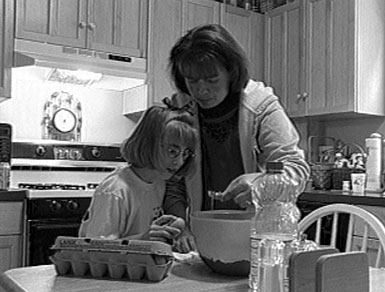
|
|
Allison looks just like any other kid as she helps her mother bake a batch of brownies. But she has cerebral palsy, and two of her three siblings have other developmental and learning disabilities related to their premature birth. Her family is featured in a film that explores some of the issues raised by neonatologists' ability to save more and more premature babies. This and all the other images in the article are from the film itself. |
The film's producers, neonatologist George Little, M.D., and ethicist Ronald M. Green, Ph.D., won't say. "If you know the answer to that question, you see the film in a different way," Little explains. "We're trying to stimulate thought and have [viewers] develop insight into . . . how parents relate to health professionals."
It's true that Dreams and Dilemmas, which has been aired on public television and shown to thousands of medical students, residents, nurses, and other health-care personnel around the world, has been an effective teaching tool about neonatal medical decision-making. Still, the question viewers raise is an important one. What does happen to those NICU survivors after they leave for home?
This fall, Little, Green, and Kahn will release a new documentary, titled In Our Midst, that addresses the issue of neonatal outcomes. The Greenwall Foundation, which underwrote the production of the first film, has provided more than $200,000 to produce the new one. As he did in making Dreams and Dilemmas, Kahn captured reality by filming his subjects as they went about their business, day in and day out. This time the setting is a home environment. The "cast" is an apparently ordinary middle-class family: parents Karen and Bob and their children Alex, 12; Andrew, 11; Allison, 9; and Aiden, 6. All of the children spent their first months of life in DHMC's NICU (the acronym is pronounced "NICK-yew").
A slice of life
The idea for the first film arose in the early 1990s at a conference in Burlington, Vt., where a group of activist parents of premature babies developed a set of "Principles for Family-Centered Neonatal Care" (later published in the journal Pediatrics). The principles' underlying philosophy—that neonatal care should involve open communication between parents and health-care professionals—was the basis for Dreams and Dilemmas. The excruciatingly moving film shows real-life parents participating in decisions about their premature newborns.
In Our Midst, on the other hand, gets "at the issue of how families do after they leave NICU," says Little. It "emphasizes the outcomes and the home environments—the results from decisions made in the NICU." Making this second film was harder than the filmmaker and the producers had expected. "It was easy to make Dreams and Dilemmas. It had dramatic moments about life and death that anybody can relate to," says filmmaker Kahn. In Our Midst "was much more difficult because it was about daily living. It was a slice of life. It's all about subtlety. It resonates with everyone's life, but it's slightly rotated. The toughest thing was making a film about a middle-class family where nothing really special happened."
Kahn paints a portrait of this family through a series of "snapshots" recorded over a year. (The film never reveals where they live, however, and uses only first names for all the family members.) Viewers see a loving, nurturing, ever-patient mother who tends to her children's medical, nutritional, educational, and emotional needs; who is constantly shepherding her two youngest through a maze of doctor and clinic visits; who is forever preparing special foods and administering tube feedings as well as fixing regular meals; who is a ferocious advocate for her children; and who also seems to enjoy simply spending time with them—playing, talking, baking brownies. Viewers also see a supportive, loving father who works long hours outside the home and who participates in the children's care as much as he can. And they see four children who are charming, fun-loving, respectful, obedient, and even willing to clean up after themselves without being told.
The film addresses more subtly the fact that all of the children except for Alex have some problems stemming from their days in the NICU: Andrew has some learning and emotional difficulties; Allison, who had a brain hemorrhage as a baby, has cerebral palsy, suffers frequent seizures, needs physical and occupational therapy, has to get some of her nutrition via tube feedings, and may never be able to master the second-grade curriculum; and Aiden, who was adopted, is in kindergarten, is legally blind and hearing-impaired, has learning and developmental disabilities, and is fed largely through a tube that's attached to his stomach and hooked up to a pump at night. But the film doesn't dwell on the technical aspects of these disabilities. In fact, though it shows Karen mixing the ingredients for the tube feedings, it never depicts how the feedings take place.
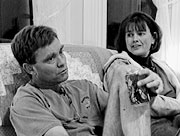
|

|
|
The film addresses more subtly the fact that all of the children except for Alex have some problems
stemming from their premature birth. But it doesn't dwell on the technical aspects of these disabilities. | |
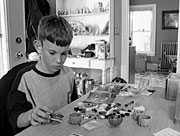
|
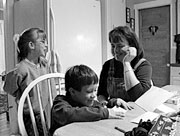
|
"I didn't show it primarily because the film wasn't about procedure so much as it was about lifestyle," says Kahn. "There wasn't a lot to her plugging Aiden in." By leaving out such technical details, Kahn hoped to preserve the "rhythm of the film."
Critics might argue that the film does too good a job of making the family seem ordinary and that it fails to convey the harsh reality that some disabled NICU graduates may belong to families who lack the financial resources or the ability or even the will to cope with their children's disabilities.
"I would have made a more gripping film in the sense of the way Dreams and Dilemmas is gripping if I had chosen a family that was struggling financially and where the kids were not so happy and the mother not so happy," says Kahn. "But I didn't think that would surprise anybody. I think seeing the best situation, and how difficult it can be, makes the film raise more questions about what's going on."
Raising questions
"I think the question in the film is 'Can everybody do what Karen does?'" says Little. "What we see is Karen managing a family that has a spectrum of problems, and she seems to do it very well. The real question is, 'Can the average person do it?' I think the answer to the question is yes, but perhaps not with the degree of skill and ability that Karen is able to employ."
A viewer might wonder, for example, what would happen if Karen had to hold down a job outside the home. How would she cope with her children's disabilities then? "The film makes you think about that," says Little. "It doesn't show you single mothers. It doesn't show you people who are economically disenfranchised, but it sure makes you think about how those people would cope."
The film does show "how a child like this takes up your whole life," notes Jerold Lucey, M.D. Lucey, an advisor on both films, is a 1948 graduate of Dartmouth College, a neonatologist at the University of Vermont, and the editor of the journal Pediatrics. He feels that In Our Midst "brings home some of the major problems involved in the care of a child after discharge. There's a huge amount of work."
"One of the points the film makes is that intense parental commitment can make a difference," comments Green, who is the director of Dartmouth's Ethics Institute. "A youngster who has a number of challenges can move forward if the parents are there 150 percent. And that's what you're seeing in this film."
The producers' intention is that the film will be used for training with health-care professionals, in the same way that Dreams and Dilemmas has been, and to stimulate questions among them as well as among parents and the public. So far, In Our Midst has been seen only by members of the film's advisory board—a mix of health-care providers and parents—as well as by a few test audiences. But if early reactions are any indication of what lies ahead, the film is sure to fulfill its producers' expectations.
Filmmaker Kahn believes viewers' reactions are more revealing about their own perceptions than about the film. "Everybody watches the film and they tell you about themselves, they're not telling you about the film," he observes. "One person said, 'This is terrible. I can't believe we do this to people. Neonatologists watching this are going to be freaked out.' And the neonatologist sitting next to the guy said, 'Oh, no. This is a happy family. These are happy kids.'"
Kahn is pleased that people have such different responses. "As the filmmaker, that's the point. It's not for me to say this is good or bad. It's for me to say this is what it is. But it's surprising to me—in every film, people just look at things from their own planet."
The doctors have noticed the variation in responses as well. Lucey recalls some viewers who wanted to know more about the tube-feeding procedures, for example. Little, however, says that "some people clearly move beyond the focus on the technical details—like where is that food being injected—into this family."
He describes one physician who spent a lot of time asking about details but another who stated, "'My mind was there in the beginning, but it quickly moved into the total construct of this family and where they were. I thought less about small details and more about the family structure, where they were going, the pressures on them, how they'd adapted, their perceptions of each other, and things like that.' I have a hunch," Little adds, "that I'm going to see more of that [variation] as we show the film."
Kahn was also intrigued by the viewers' reactions to the parents' differing roles. "There are people who see Karen as being patient and loving and kind—a supermom—and are disturbed that they don't see a lot of Dad, or that when they do he's not up on the medications. But it's just not the way their family works. It's not that he's a bad guy."
"For me," says Green, "one of the learning experiences for this film is to see how resilient human beings can be with good care. I was surprised at how remarkably well this family has adapted to challenges that would have overwhelmed me."
Little explains that In Our Midst "is another step to make those of us who work in the NICU—doctors and nurses and all the health-care providers—take a moment and think about what happens afterwards. Parents, and many of us who are providers, think that sometimes we don't think enough about what's coming down the road."
Most NICUs have social workers, discharge nurses, and other caregivers who can furnish families with various resources—information about insurance, organizations, government agencies, support groups, and so on—that they can turn to for help once they leave the hospital. But Little hopes that the film will deepen all NICU staffers' appreciation of what lies ahead for such families.
Little, who established DHMC's NICU 30 years and 12,000 babies ago, says that the new film has sensitized him to the issues and has made him more empathetic. "It made me think very seriously about whether I could do what Karen does," he admits.
Little and Green worked closely with Kahn throughout the filming to help frame the issues and questions that should be raised and to make sure they were adequately addressed. At the same time, they were careful not to interfere with the concept of reality-based filming. "We're trying to get the viewers to become part of the family, to live with these kids for a while, in their heads," says Little. "As doctors and nurses, we are taught to be scientific. We're taught to look at things objectively." He's not suggesting that health-care workers stop being objective, but he believes that "part of the process of being a healthcare provider and taking care of babies and families is to truly be able to empathize and understand what is going on in that family.
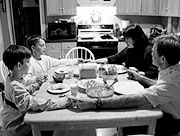
|
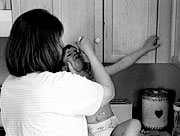
|
|
Little explains that the film "is another step to make those of us who work in the NICU—doctors and
nurses and all the health-care providers—take a moment and think about what happens afterwards." | |

|

|
"Reality-based films are a very effective tool for doing this," he says. In one scene from In Our Midst, Bob and Karen's impatience is evident as they wait to see the doctor while Allison and Aiden play nearby. "What the filmmaker was trying to do there was to use that as an example of how the system interacts with children with special needs, and how difficult, and how stressful, and how time-consuming those interactions with well-meaning people can be," Little says.
Considering controversy
Still, will having a better understanding of those difficulties make a difference in the decisions that are made in the NICU? Studies that have looked at NICU graduates indicate that most are happy and managing well. Saroj Saigal, M.D., a neonatologist at McMaster University in Ontario, has published several quality-of-life studies showing that even NICU graduates with disabilities ranked themselves higher in terms of self-satisfaction than did members of a control group. But "now those studies have been challenged," says Green.
Helen Harrison—the mother of a 27-year-old son who was born prematurely and the author of The Premature Baby Book—was one of the parents on the advisory board for Dreams and Dilemmas. She recently published in the Journal of Clinical Ethics an article titled "Making Lemonade: A Parent's View of 'Quality of Life' Studies." In it, she disputes Saigal's findings, contending that societal pressures force families of disabled prematurely born children to appear happier and braver than they really feel. Harrison says such families feel compelled to "make lemonade out of lemons."
Lucey, who invited Harrison to that original gathering of parents in Burlington a decade ago, doesn't agree with everything she says nowadays. However, he does believe that her theme of "mothers having to pretend they're noble . . . is true." He adds that Harrison has become "a lightning rod for people who've had terrible results."
In fact, the whole field of "neonatal care in our society is a lightning rod," says Little. "There are people concerned about outcomes. There are people concerned about the financial end of it. There are people concerned about some of the bioethical aspects and decisionmaking. It's a controversial arena."
Lucey, who's spent more than 30 years in intensive-care nurseries, says, "I've had only one or two parents want to give up." The family in the film obviously had no intention of giving up on their babies in the NICU and has been extraordinarily committed since then to making sure the children get whatever they need. Incidentally, the parents were on the advisory board for Dreams and Dilemmas and so knew what they were getting themselves into when they agreed to be the subjects for In Our Midst.
Reflecting on the medical decisions that face the parents of tiny preemies, Bob says in the film, "You have to be objective. You have to be able to say, 'In our medical expert opinion, this child may or may not have a tremendous quality of life.' Had you given that information to us regarding Allison, let's say, we would have said, 'Okay, you know, she's in our midst. And she'll stay in our midst. High quality or low quality.' Other families might say, 'We just can't do that.'" �
Laura Carter is the associate editor of Dartmouth Medicine magazine.
